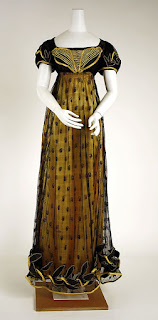The most memorable writers I’ve encountered have a way of
throwing you into the story through your senses. Think of Zora Neal Hurston’s
description of Janie lying under the peach blossoms, or Jack Kerouac chronicling his manic, visceral, joyous romp across the United States.
Primary sources are our surest means of knocking the dust
off the past and getting our hands on it. They are goldmines for writing
historical fiction, and here are three ways I’ve used them for my current
novel-in-progress.
 |
| Evening gown, c. 1810. The Met. |
The item: Letters written by Lady Katherine Cochrane
Kate’s surviving letters, held at the National Library of Scotland and the National Records of Scotland and
elsewhere, offer an engaging look at a charming, strong-minded, brave, affectionate,
resourceful, stubborn, sexy woman - with a bit of a temper. Next to speaking
with her, the letters have offered me the best way to hear her voice. Whether
she’s reminding her husband of her brilliant success in helping him attain a
pardon from the British government, or lamenting her separation from her
children, she’s a force to be reckoned with.
My favorite line – so good it could have come from Jane
Austen – is “With a few dinners and a little flattery I might accomplish a
great deal."
The item: Clothing
from the collection of The Metropolitan
Museum of Art
A heroine must be
dressed! But how? Thanks to the Met’s collection of Regency clothing – much of
which has been digitally photographed– I gained a sense of what a woman like
Kate might have worn for day-to-day activities as well as special events like
balls.
The item: a
reproduction of an 1816 cookbook
 |
| Homemade strawberry preserves. |
As soon as I saw A New
System of Domestic Cookery by Mrs. Rundell listed in the Persephone Books catalog, I knew I
had to have it! Not only is it an invaluable source of what people ate and how
meals were prepared, it includes the early 19th-century version of
Hints from Heloise. There are tips for mending broken china, making homemade
ink, and removing stains from linen.
I’ve found that in the era before freezers, refrigeration,
and chemical preservatives, food was much more seasonal! Mrs. Rundell's book includes monthly menus of what meats, fish, game, vegetables, and fruits are available, and also offers suggestions for
Mutton collops, anyone?
